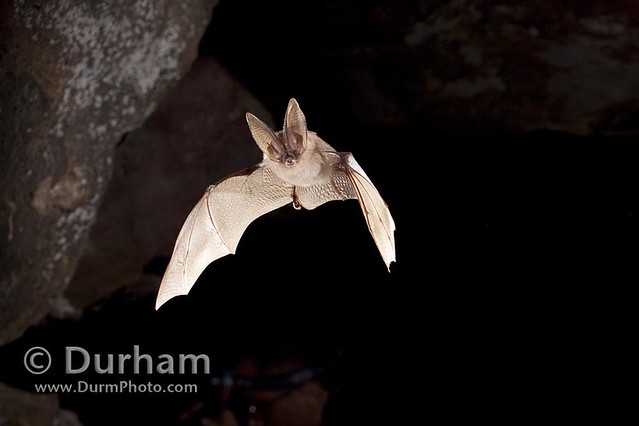Corynorhinus townsendii Cladus: Eukaryota Name Corynorhinus townsendii Cooper, 1837 Type locality: USA, Washington, Clark Co., Fort Vancouver. Synonyms * Plecotus townsendii
* Cooper, 1837. Ann. Lyc. Nat. Hist., 4: 73.
* North American Mammals: Corynorhinus townsendii [1]
* British Columbia (Canada) through Western USA to Oaxaca (Mexico), east to Virginia
Townsend's Big-Eared Bat (Corynorhinus townsendii) is a species of vesper bat in the Vespertilionidae family.
The Townsend's Big-Eared Bat is a medium-sized bat with extremely long, flexible ears (hence the name) and small yet noticeable lumps on each side of the snout.Its upperparts are similar to dark brown on the back, and wood-brown on the sides. The underparts are a slightly paler shade of brown. These bats can be identified by the nearly uniform color of their bodies. Its total length is around 10 cm (4 in.), its tail being around 5 cm (2 in.) It's wingspan is about 28 cm. It weighs around 7–12 grams.[2] Diet The Townsend Big-Eared Bat's diet includes small moths, flies, lacewings, dung beetles, sawflies, and other small insects.[2] Range C. townsendii can be found in the following countries: Canada, Mexico, and United States.[1] This bat is often distributed near rocky areas where caves or abandoned mine tunnels are available. They may also occasionally inhabit old buildings.[2] Reproduction The mating season for the Townsend's Big-Eared Bat takes place in late fall. As usual, courtship rituals are done by the male. Until spring, when ovulation and fertilization begin, the female stores the male's sperm in her reproductive tract. Gestation lasts from 50 to 60 days. When the pup is born, it is pink, naked, and helpless. Only one pup is birthed per female, although 90% of females give birth.[3] Life The average lifespan of a Townsend's Big-Eared Bat is 16 years.[4] During summer, males and females occupy separate roosting sites. Males live a solitary lifestyle away from females. Females and their pups form maternity colonies which often number from around 12 to 200, although in the eastern United States colonies of 1,000 or more have been formed.[2] During the winter these bats hibernate, often when temperatures are around 32 and 53°F (around 0°C and 11.5°C.) Hibernation occurs in tightly packed clusters, which could possibly help stabilize body temperature against the cold. Males often hibernate in warmer places than females and are more easily aroused and active in winter than females. The bats are often interrupted from their sleep because they tend to wake up frequently and move around in the cave or move from one cave entirely to another. During hibernation, C. townsendii grow incredibly fat, which compensates for the food they do not eat during the winter with a low metabolism.[2] Taxonomy Members of the genus Corynorhinus were previously in the genus Plecotus. Subspecies Four subspecies exist: * C. t. townsendii References 1. ^ a b Arroyo-Cabrales, J. & Ticul Alvarez Castaneda, S. (2008) Corynorhinus townsendii In: IUCN 2009. IUCN Red List of Threatened Species. Version 2009.2. www.iucnredlist.org Retrieved on 2010-01-25. Source: Wikipedia, Wikispecies: All text is available under the terms of the GNU Free Documentation License |
|


